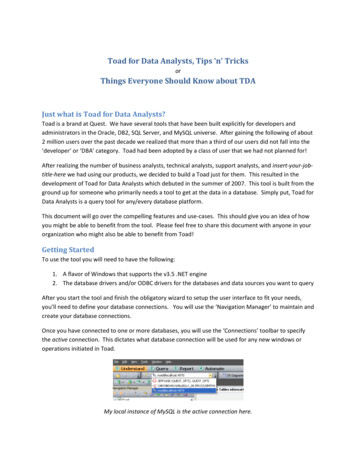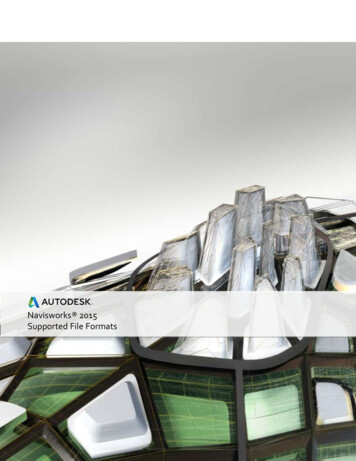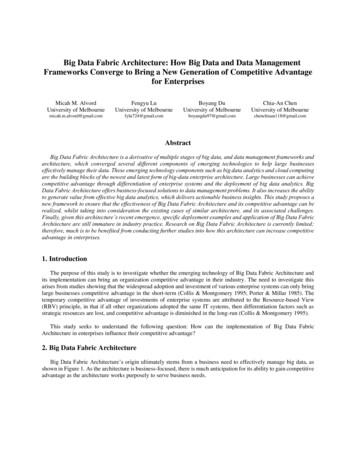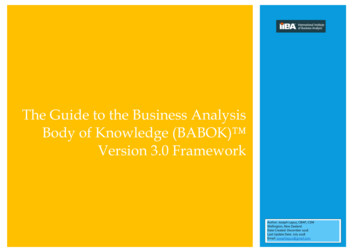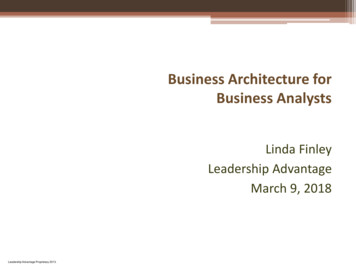
Transcription
Business Architecture forBusiness AnalystsLinda FinleyLeadership AdvantageMarch 9, 2018Leadership Advantage Proprietary 2013.
2Presentation Focus The definition, scope and the current state ofbusiness architecture, available resources, andactivities. The practical value of a business architecture forbusiness analysts. Business architecture tools and techniques forbusiness analysts.Leadership Advantage Proprietary 2013.
3A Brief History of Business Architecture 1995 – The Open Group Architectural Framework (TOGAF) 2007 – Object Management Group (OMG) Business Architecture SpecialInterest Group (BASIG) and Business Architecture Working Group (BAWG) 2010 – Business Architecture Guild Formation & subsequent publicationof the BIZBOK Guide Business Architecture Body of Knowledge 2010 – Twin Cities Business Architecture Forum Community of Practice islaunched 2012 – The Business Architecture Institute is established 2012 – Metro State Business Architecture Certificate is created 2016 – The Business Architecture Summit 2017 – IIBA PDD collaboration with TCBAF September 20th! 2017 – The 2nd annual Business Architecture Summit December 7th! Tomorrow--TBDLeadership Advantage Proprietary 2013.
4What it is and What it isn’t Business architecture is not a buzzword or a quick fixsolution for a broken process, a computer system, ora single project or business unit. It is a holistic discipline that is most effective whenapplied across business units, practices, disciplines,and stakeholders.Chapter 2, Part 1, of Business and Dynamic Change: The Arrival ofBusiness Architecture, Published by Future Strategies, Inc. 2015Leadership Advantage Proprietary 2013.
5Definition The scope of business architecture is the scope of thebusiness. Business Architecture aids in defining and creating yourenterprise to deliver your purpose. It enables you to understand and optimize your organization’scapabilities and competencies. It links business and technology through applications andinformation. It helps us visualize and convey current and future businessopportunities to the organization. It is the discipline to align people, process, tools, andinformation with current and future business goals.Leadership Advantage Proprietary 2013.
6From WikipediaLeadership Advantage Proprietary 2013.
7Business Architecture knowledgebase“A blueprint of theenterprise thatprovides acommonunderstanding ofthe organizationand is used toalign strategicobjectives andtacticaldemands."Leadership Advantage Proprietary 2013.
8Four core domainsThe Guide to the Business Architecture Body of Knowledge(BIZBOK Guide ) defines four core business architecturedomains: Value Streams Capabilities Organization InformationLeadership Advantage Proprietary 2013.
9FoundationTechnologyArchitecture Multi disciplinary Differing, blendedperspectives IT Business Executives Arose out of a needLeadership Advantage Proprietary 2013.BusinessProcessManagementStrategy iza onalDesignProjectManagement
10The Role "Business architecture is about making sure the whole business holdstogether“ It's a role built around business planning, pointing out opportunities toutilize IT more effectively -- in sales, customer service, and all other areas. fashioning high-level company strategy with technology in mind. The job of the business architect is to arm leaders with the knowledgethey need to choose wisely. Identify Understand Visualize OptimizeLeadership Advantage Proprietary 2013.
11Business Architecture FitLeadership Advantage Proprietary 2013.
A Business Architecture FrameworkIdentify anddescribeeach aspectwithin thebusinessarchitectureframework
13Business Change DriversBusiness architecture building blocks are combined based on different businessscenarios in order to provide executive management with the information itneeds to make strategic decisions. Scenarios where business architecture hasbeen and can be used include: Investment AnalysisShift to a Customer Centric Business ModelMerger and Acquisition AnalysisNew Product/Service Roll OutGlobalizationBusiness Capability OutsourcingSupply Chain StreamliningDivestitureRegulatory Compliance/ImpactChange ManagementOperational Cost ReductionJoint Venture DeploymentLeadership Advantage Proprietary 2013.Different businessarchitecture views arecombined to supportdifferent businessscenarios
14The Business ArchitecturePurposeCapabilitiesLeadership Advantage Proprietary 2013.Performance
15The Business Architecture—ask “Why”WhyPurposeCapabilitiesLeadership Advantage Proprietary 2013.Performance
16Start with “Why”The Difference We Make Purpose Vision Mission Value Proposition Business ModelLeadership Advantage Proprietary 2013. Who are we? What is our organization’spurpose? Who do we serve? What is the Value Proposition weoffer? Why do we exist? What makes us special—how dowe differentiate ourselves? Why do we matter to themarketplace and to the world?
17Business Model TriggersLeadership Advantage Proprietary 2013.
18Business Model Canvas
19Value Proposition
Customer ProfileCustomer ProfileThe Customer segment profile should be used to describe a specific customersegment in your business model.Customer PainsDescribes bad outcomes,risks and obstacles related tocustomer jobs.Customer GainsCustomer JobsThis sector describes whatcustomers are trying to getdone in their lives.Describes the outcomescustomers want to achieve orthe concrete benefits they areseeking.Source: Value Proposition Design, A. Osterwalder, et.al.
Value Proposition Value MapValue MapThe Value Map profile should be used to describe the features of a specific valueproposition in your business model.Gain CreatorsProducts andServicesThis should include alist of all the Productsand Services a specificvalue proposition isbuilt around.Describes how your productsand services createcustomer gains.Pain RelieversDescribes how your productsand services alleviatecustomer pains.Source: Value Proposition Design, A. Osterwalder, et.al.
22The “What” of Business Architecture What must we do to deliver ourbusiness’ purpose? What do we need to deliver ourwhy? What redundancies exist in theorganization? Where are our opportunities in thefuture? Do our investments and ourattention align with our purpose?PurposeWhatCapabilitiesLeadership Advantage Proprietary 2013.Performance
23Align the “What” Capability Enablers Organization People Skills and Competencies Process Value Streams Information Flow Business RulesLeadership Advantage Proprietary 2013. Tools and Technology Models Maps Charts Diagrams Applications Information Data
24Business CapabilitiesBusiness Capabilities: Represent “what” we do as a business to consistently deliver an expectedresult to the marketplace Defined by people, process, technology (including data) Capability modeling and analysis pictorially shows how functions areorganized to deliver the business purposeBusiness Capability Planning: Encourages and facilitates cross-organizational discussions Provides a common framework and language for defining, aligning andoptimizing our business purpose, monitoring and planning investments, andachieving operational effectiveness Identifies redundancy, synergies and reuse opportunities across theenterpriseLeadership Advantage Proprietary 2013.
25Capability Map
Example: Business Capability Map2.0 – ProductManagement2.1 – MarketDefinition2.2 – ProductStrategy Creation2.3 – Business PlanDevelopment2.4 – MarketSolution Design2.5 – ProductRollout2.1.1 – Target MarketIdentification2.2.1 – ProductPortfolio Management2.3.1. – ProductInnovationManagement2.4.1 – Buyer and UserPersona Definition2.5.1 – Product LaunchPlanning2.1.2 – MarketOpportunity Analysis2.2.2 – ProductRoadmap Definition2.3.2 – ProductDevelopmentApproach Planning2.4.2 – Buying ProcessDesign2.5.2 – Channel PartnerEducation2.1.3 – CompetitorAnalysis2.2.3 – ChannelDistribution Definition2.3.3 – Channel PartnerStrategy Creation2.4.3 – ProductPositioning Analysis2.5.3 – ProductEffectivenessEvaluation
27The Business Architecture—how well?PurposeHowCapabilitiesLeadership Advantage Proprietary 2013.Performance
28How Well Behaving and Performing Capability Maturity Assessment Competency Organizational inhibitors Change Management Decision-making Models Metrics and Measurement Leadership Culture Roadmaps Roles and ResponsibilitiesLeadership Advantage Proprietary 2013. What is enabling or inhibitingour ability to deliver ourbusiness’ purpose? How can we more successful? How do we measure ourachievements and our success? Is our culture supporting ourpeople, process and tools? How do we anticipate andmanage change? How well is our “what”delivering our “why”?
29BUSINESS CAPABILITYFRAMEWORKBusiness capabilities and competenciesLeadership Advantage Proprietary 2013.CORE COMPETENCIESCOMPETENCIESBASELINECompetencies that by theirperformance becomestrategic differentiators forthe organization.Business Capabilities that theorganization consistently doeswell (effectively andefficiently).Business Capabilities thatthe organization does, butnot consistently well(effectively or efficiently).
30Maturity erit fromtheir “children”.A commonmethod toreport results isto use a HeatMap concept.Leadership Advantage Proprietary 2013.
31Simple Strategy Map
32HelpfulHarmfulto achieving the objectiveto achieving the objective(attributes of theorganization) Identification of SWOTs is important becausethey can inform later steps in planning toachieve the objective.Internal origin Strengths: characteristics of the business orproject that give it an advantage over others Weaknesses: are characteristics that place theteam at a disadvantage relative to others Opportunities: external elements that theproject could exploit to its advantage Threats: external elements in the environmentthat could cause trouble for the business orprojectExternal originThe technique is credited to Albert Humphrey,who led a convention at the Stanford ResearchInstitute (now SRI International) in the 1960sand 1970s using data from Fortune 500companies.[1][2]SW(attributes of theenvironment)Basic SWOT AnalysisOT Humphrey, Albert (December 2005). "SWOT Analysis for Management Consulting". SRI Alumni Newsletter (SRI International). http://alumni.sri.com/newsletters/Dec-05.pdf. "Albert Humphrey The "Father" of TAM". TAM UK. http://www.tamplc.com/Humphsprofile.htm. Retrieved 2012-06-03.
33Capabilities aligned to strategyLeadership Advantage Proprietary 2013.
34Strategy mapStrategic objective:Partner with GroceryStore Chain tosuccessfully expandproduct into a newmarket.Leadership Advantage Proprietary 2013.
35Enabling StrategyPurposeStrategy Action towards PurposeWhat might we be?What could we become?Current StateCapabilitiesFuture StatePerformanceCapabilitiesPerformanceLeverage and GrowImproveLeadership Advantage Proprietary 2013.
36ReferencesLeadership Advantage Proprietary 2013.
37ResourcesBusiness Architecture InstituteA peer to peer exchange for businessarchitecture professionalshttp://www.bainstitute.org/The Twin Cities Business Architecture Forum(TCBAF) is a Minnesota-based organizationdedicated to the understanding andadvancement of the role and professionalpractice of Business Architecture.www.tcbaf.orgLeadership Advantage Proprietary 2013.
38The Twin CitiesBusiness Architecture ForumLeadership Advantage Proprietary 2013.
39The Business Architecture Links and solidifies the Why, What and How well Identifies the highest level of business requirements Ensures that the operating model can deliver the business purpose Provides mechanisms to “connect the dots” throughout the organization todefine and drive delivery Identifies common cross-organizational needs and captures synergies forcollaborative investment decisions Used to help the organization focus on the highest impact capabilitiesthrough analysis and prioritization Is used to identify redundancies, reuse and improvementopportunities and strategyLeadership Advantage Proprietary 2013.
40QuestionsLeadership Advantage Proprietary 2013.
41Contact InformationLinda Finleyfinleylinda@gmail.com763.639.6564
42Business Model CanvasLeadership Advantage Proprietary 2013.
2010 –Business Architecture Guild Formation & subsequent publication of the BIZBOK Guide Business Architecture Body of Knowledge 2010 –Twin Cities Business Architecture Forum Community of Practice is launched 2012 –The Business Architecture Institute is established 2012 –Metro State



